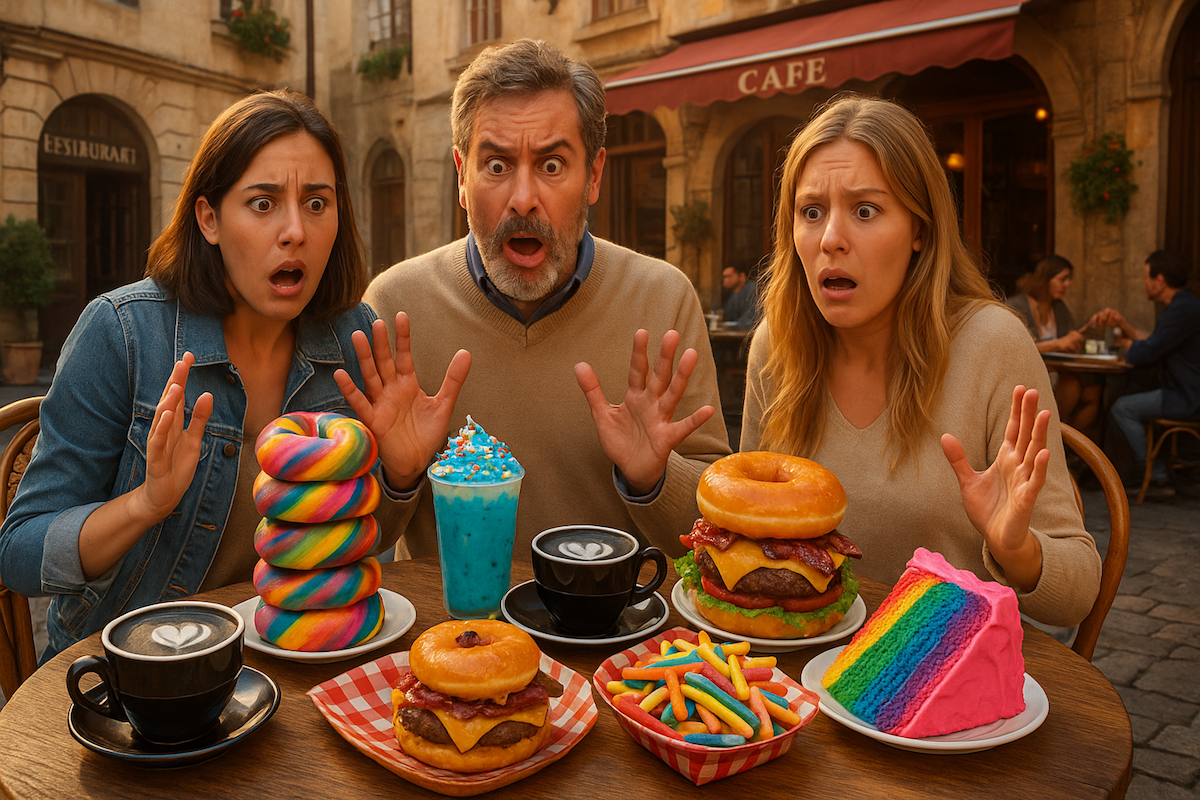Contents
- When Bread Meets Bedazzling: A Transatlantic Food Culture Clash
- 1. Rainbow Everything… Because Beige Is Too Boring
- 2. Gold Leaf Tacos… Literal Wealth Flex on a Tortilla
- 3. Charcoal Lattes… Burnt Wood, but Make It $8
- 4. Pumpkin Spice Mania… The Seasonal Cult
- 5. Deconstructed Meals… When Your Food Is Just a Puzzle
- 6. Fake Healthy Ice Cream… 20 Grams of Protein, 0 Grams of Joy
- 7. Extreme Portions… “Why So Much?” Says Everyone in Europe
- So, Is It Innovation or Insanity?
- What’s Your Verdict?
When Bread Meets Bedazzling: A Transatlantic Food Culture Clash
From Rainbow Bagels to Charcoal Lattes, These Are the Culinary Crimes Europeans Just Can’t Forgive
I once tried explaining a rainbow bagel to a baker in rural France.
He blinked.
Tilted his head like I’d just confessed to microwaving escargot.
Then, with the slow disdain only a Frenchman can pull off, he said, “So… it is for a child’s birthday?”
That same week, I showed a Spanish friend a picture of a glitter-covered donut I saw trending online. She looked genuinely concerned.
“Is it… safe?” she asked, like I’d just offered her a spoonful of uranium.
After more than two decades living outside the U.S., from the post-Soviet grit of Ukraine to the mountain cafés of the Pyrenees, I’ve learned that America’s culinary creativity is a global punchline.
In France, a croissant is a thing of poetry.
In Bulgaria, yogurt is practically sacred.
Meanwhile, back in the U.S., we’re slapping gold leaf on tacos, stuffing cereal into sushi rolls, and drinking activated charcoal like it’s holy water.
If you’ve ever tried to explain “deconstructed avocado toast” to someone in Albania, you’ll understand the blank stare that follows.
My favorite waitress in my favorite Georgian restaurant in Tbilisi once said it best,
“You Americans like your food to look like art, so you forget it doesn’t taste good.”
In this article, we’re diving fork-first into seven of the most ridiculous U.S. food trends, each one more absurd than the last.
And I promise you, somewhere in Spain, someone is already judging you for your pumpkin spice obsession.
1. Rainbow Everything… Because Beige Is Too Boring
The first time I saw a rainbow bagel, I thought it was a marketing prank.
Bright stripes of artificial color swirled into what used to be a decent breakfast food.
In New York, it’s a trend.
In Europe, it’s a crime against bread…. and humanity.
When I showed a French baker in Béziers a photo of rainbow grilled cheese, he leaned forward like he was analyzing a crime scene.
“Why would you do that?” he asked, not sarcastically, but in genuine confusion.
In places like France, Spain, and Italy, food isn’t just fuel or flash, it’s cultural identity.
You don’t mess with it to get likes.
Bread is sacred. Cheese is serious.
The idea of making it look like something out of a toy store is borderline offensive.
Reality Check: When your food has more color than a Monet painting, expect a European to assume it belongs at a children’s party… not on a plate.
2. Gold Leaf Tacos… Literal Wealth Flex on a Tortilla
I saw a gold-leaf taco trending from a restaurant in Las Vegas.
Price tag? Around $500.
Inside was wagyu beef, truffle oil, caviar, and a tortilla wrapped in 24-karat edible gold. As if anyone actually orders it for the taste.
Meanwhile, in the backstreets of Tbilisi, I once had lobio, pickled vegetables, and fresh shoti bread straight from a tone oven.
Total bill: about $3.
It fed me for hours and still ranks as one of the most satisfying meals I’ve ever had.
Europeans see food as something to nourish and connect.
Americans sometimes treat it like a jewelry display.
In places like France, Spain, Poland or Georgia, excess for the sake of status is something people recognize, and mock.
Reality Check: When your taco is shinier than your future, it’s probably not about the food anymore.
3. Charcoal Lattes… Burnt Wood, but Make It $8
I ordered a charcoal latte in Florida once. It looked like a potion out of a dystopian novel and tasted like warm water filtered through a fireplace.
Supposedly “detoxifying.” What it actually did was confuse every European I told.
A Bulgarian pharmacist I met in Blagoevgrad thought I was kidding when I explained it.
“You drank activated charcoal?” he asked, blinking. “For fun?”
Charcoal is something they use medically in emergencies to absorb poison.
The idea of sipping it recreationally made about as much sense as snacking on toothpaste.
Reality Check: If the thing you’re drinking is usually administered in a hospital setting, it probably shouldn’t be on a café menu.
4. Pumpkin Spice Mania… The Seasonal Cult
Pumpkin spice isn’t a flavor. It’s a marketing machine that takes over America every fall.
You’ll find it in lattes, candles, Pop-Tarts, cereal, protein bars, and deodorant.
Yes, deodorant.
And Americans embrace it like it’s a national holiday.
I tried explaining this to a friend in Kraków.
He asked if it was a traditional harvest ingredient or had cultural significance.
I said no, it’s just what we put in everything once the leaves turn orange.
His silence was louder than his judgmental side-eye.
In Europe, pumpkins are generally roasted or blended into soup. Maybe baked with a little garlic.
But you’ll never see a Parisian walking into a café and asking for a pumpkin-scented macaron with a side of Halloween nostalgia.
Reality Check: What Americans see as cozy and seasonal, Europeans often see as a scented candle you accidentally drank.
5. Deconstructed Meals… When Your Food Is Just a Puzzle
A friend of mine from Brooklyn, told me while ranting about how “gentrified” the place had become, used ordering the “deconstructed” burger as an example.
He said it had arrived as raw greens, an undercooked patty, a single tomato slice, and a “pipette” of aioli, all laid out like some Williamsburg hipster forgotta’ finish their shift.
No plate, just a wooden slab.
This kind of plating would never fly in places like Spain, France or Italy, where food comes as a cohesive whole.
I’ve had three-course meals in Spanish bodegas where the plating was minimal, but the flavor was unforgettable.
There’s no ego in the presentation… only pride in the recipe.
Europeans understand minimalism.
What they don’t understand is why Americans are paying extra to do the chef’s job themselves.
Reality Check: If your meal comes with instructions, it’s no longer dinner… it’s performance art.
6. Fake Healthy Ice Cream… 20 Grams of Protein, 0 Grams of Joy
High-protein, low-sugar, zero-fat ice creams are everywhere in the U.S.
They promise all the indulgence without the calories.
What they actually taste like is frozen sandpaper rolled in Splenda.
I once tried to sell the idea to a Spanish friend in Ferrol while we were eating real gelato.
She didn’t even answer.
She just handed me another scoop of turrón and shook her head like I’d insulted her grandmother.
Across Europe, dessert is meant to be enjoyed… not negotiated.
In France, you eat the pastry.
In Spain, you lick the cone clean.
No one is counting macros. No one is asking if it’s keto.
It’s dessert. It’s supposed to make you happy.
Reality Check: If you need a protein count to justify eating ice cream, maybe the problem isn’t the ice cream.
High-protein, low-sugar, zero-fat = Zero taste.
7. Extreme Portions… “Why So Much?” Says Everyone in Europe
Take one French friend to a Cheesecake Factory and you’ll never hear the end of it.
I did.
When his pasta arrived, he looked up at me and asked if it was a mistake.
“This could feed three families,” he said, stunned. “Why do you need this much?”
In the U.S., big portions equal value. More is better.
In Europe, especially places like France or Poland, the goal is balance.
Meals are sized for one person.
You’re supposed to finish them and feel content, not bloated and ashamed.
Once in rural Bulgaria, I had lunch that included soup, a main course, salad, and compote… all served in human-sized portions.
No guilt. No waste.
And no need for a nap or a wheelbarrow to get home either.
Reality Check: If your entrée requires a second table just to hold it, maybe it’s not a meal… it’s a warning sign.
So, Is It Innovation or Insanity?
There’s a fine line between creative and ridiculous. Some U.S. food trends are clever, fun, and even delicious.
But many feel more like attention-seeking, clickbaity stunts than culinary progress.
Somewhere between rainbow bagels and gold tacos, we lost the plot.
Living in places like Georgia and France taught me that food doesn’t need to scream to be good.
It doesn’t need to be reinvented every season.
Sometimes, a warm bowl of borscht or a crusty baguette does more for the soul than a glitter-covered donut ever could.
Reality Check: Just because something goes viral, doesn’t mean it deserves a place on your plate.
What’s Your Verdict?
Are we pushing boundaries, or just desperate for clicks?
What U.S. food trend made you laugh, cringe, or come on, admit it, secretly fall in love with it?
Unless it’s the rainbow grilled cheese.
Then we need to talk.

David Peluchette is a Premium Ghostwriter/Travel and Tech Enthusiast. When David isn’t writing he enjoys traveling, learning new languages, fitness, hiking and going on long walks (did the 550 mile Camino de Santiago, not once but twice!), cooking, eating, reading and building niche websites with WordPress.

